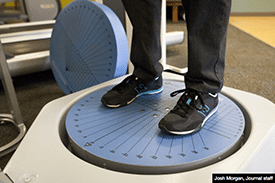
Want to lead a well-balanced life?
Put down the self-help and diet books and just try standing on one foot for a minute.
“If you can maintain a minute, you’re doing pretty well with balance,” said Erin Smith, wellness director at Westhills Village Retirement Community.
If you wobble before time’s up, don’t panic. With age comes wisdom, white hair — and wobbles.
“Unfortunately, as we age, our balance is one of the first things that we tend to lose,” Smith said.
The single-leg stance is one of the tools she uses to improve stability in her clients, most of whom are residents of the southside Rapid City retirement home. The rest are on a waiting list to move into the continuing care facility.
Either way, they’re all in a season of life that puts them at higher risk of falling.
According to the Centers for Disease Control and Prevention, one-third of adults 65 and older experience a fall.
Falling on the schoolyard playground isn’t the same as taking a spill in your golden years. Children may fall down, jump up and pick up where they left off. Lose your balance later in life, and you could be staring out a hospital window.
Falls aren’t only devastating to aging adults. They can be deadly.
Spills top the CDC’s list of leading causes of fatal injuries among older Americans.
There is a silver lining, however.
The CDC contends that “falls are a public health problem that is largely preventable.”
That’s why Smith and her colleagues give local seasoned adults the tools and training they need to anticipate and avoid becoming the latest senior sidelined by a spill.
One of those tools is the Biodex Balance System SD, which can help diagnose and treat impaired balance. A series of tests help determine if and to what extent someone is at risk for falls. Results are then translated into an interactive training program aimed at improving a person’s imbalance.
“I’ve had some people who have told me when they’re walking, they have felt like they could fall backward at any time,” Smith said. “But within a matter of a week, they felt better about their balance.”
Smith coordinates a number of wellness programs and exercise classes that promote seniors’ agility and stability. Westhills Village’s latest fitness offering puts a fresh spin on spinning. There’s no mindless pedaling in this class. Participants get to cruise around a spacious room on no-pedal balance bikes. Rapid City-based Strider Sports International manufactures the 20-inch adult version of its toddler bike for riders with special needs, and seniors fit the bill perfectly. Smith has found that participants who can no longer ride a traditional bike due to imbalance can safely resume the activity on a Strider. Adults who previously shied away from biking for fear of falling now confidently cruise around on two wheels.
The waiting list for the next installment of classes is already a dozen deep, she added.
While complex machines and two-wheeled wonders are handy for regaining and preserving balance, a gym and specialized equipment aren’t necessary.
Simple exercises can be done at home to improve balance, and several precautions can be taken around the house to reduce the chances of falling.
The American Council on Exercise, which annually educates and certifies thousands of fitness and health professionals worldwide, recommends a simple single leg stand for beginners. This activity could easily be done while brushing teeth or watching TV.
Sit-to-stand exercises may indicate fall risk, said Sandy Ommen, a physical therapist at Westhills Village. This technique involves a chair and stopwatch to record how many times a person, with arms folded across the chest, rises and sits within a 30-second period.
Ommen recommends paying attention to posture.
It turns out mom was right after all — you really shouldn’t slouch.
The more a person is bent over, the harder it is to balance, she said.
But good posture is so much more than just sitting up straight, Ommen said. Tight hip flexors and weakness through the core and spine play a part in slumped shoulders.
Seniors should consider tripping hazards in their home. Lighting is important, as well as railings and grab bars. Eyes should be regularly checked to make sure vision doesn’t impair balance. And medicines should be reviewed to identify any prescription or over-the-counter drugs that might cause dizziness.
While balance tends to decline with age, falling doesn’t have to be an inevitable part of growing older. That’s because balance is very much a use-it-or-lose-it component of aging.
“If you don’t use it, you lose it,” Smith said.
It’s never too late to begin taking back what’s been lost.
“We all age at different processes,” Smith said. “It’s not about age. It’s about what you can do right now. You’re never too young to learn.”